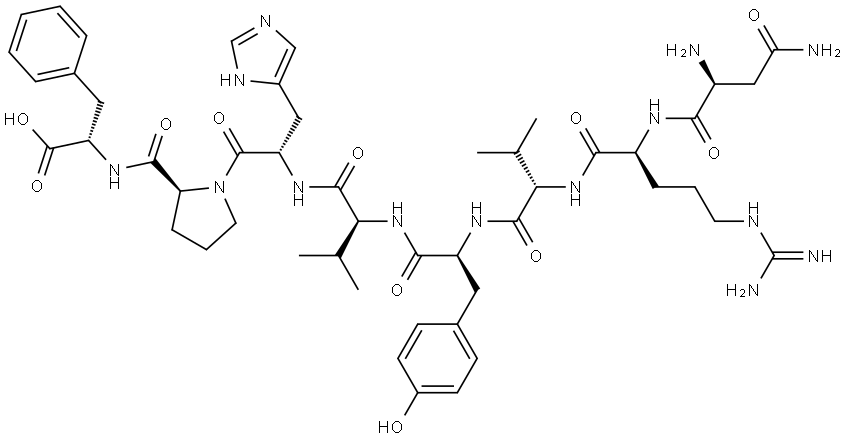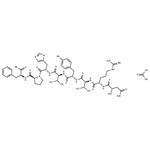
ASN-ARG-VAL-TYR-VAL-HIS-PRO-PHE
- Product NameASN-ARG-VAL-TYR-VAL-HIS-PRO-PHE
- CAS53-73-6
- CBNumberCB9735222
- MFC49H70N14O11
- MW1031.17
- EINECS200-182-3
- MDL NumberMFCD00167643
- MOL File53-73-6.mol
- MSDS FileSDS
Chemical Properties
| Density | 1.45±0.1 g/cm3(Predicted) |
| storage temp. | -15°C |
| pka | 3.56±0.10(Predicted) |
| FDA UNII | 7WAL1X78KV |
| ATC code | C01CX06 |
ASN-ARG-VAL-TYR-VAL-HIS-PRO-PHE Price
| Product number | Packaging | Price | Product description | Buy |
|---|---|---|---|---|
| Biosynth Carbosynth FA109691 | 5mg | $160 | H-Asn-Arg-Val-Tyr-Val-His-Pro-Phe-OH |
Buy |
| Biosynth Carbosynth FA109691 | 10mg | $250 | H-Asn-Arg-Val-Tyr-Val-His-Pro-Phe-OH |
Buy |
| Biosynth Carbosynth FA109691 | 25mg | $300 | H-Asn-Arg-Val-Tyr-Val-His-Pro-Phe-OH |
Buy |
| Biosynth Carbosynth FA109691 | 50mg | $450 | H-Asn-Arg-Val-Tyr-Val-His-Pro-Phe-OH |
Buy |
| Biosynth Carbosynth FA109691 | 100mg | $500 | H-Asn-Arg-Val-Tyr-Val-His-Pro-Phe-OH |
Buy |
ASN-ARG-VAL-TYR-VAL-HIS-PRO-PHE Chemical Properties,Usage,Production
Originator
Hypertensin,Ciba,W. Germany,1961Definition
ChEBI: Angiotensinamide is an oligopeptide.Manufacturing Process
48 mg (0.042 mmol) of L-asparaginyl-L-arginyl-L-valyl-L-tyrosyl-L-valyl-Lhistidyl- L-prolyl-L-phenylalanine methyl ester trihydrochloride are suspended in 0.5 ml of methanol, and treated gradually in the course of one hour with 0.3 ml of N-caustic soda solution (about 7 equivalents) so that the pH value of the solution is maintained between 10.5 and 11.5. After a further 30 minutes the solution is freed from methanol under vacuum at room temperature, adjusted with 1 N acetic acid to pH 7.4 and lyophilized. The residual mixture of free peptide and inorganic salts (79 mg) is fractionated by countercurrent distribution in the system butanol/0.1 N ammonium hydroxide. The pure octapeptide is obtained as a colorless powder which is soluble in water and methanol, more sparingly soluble in ethanol, and insoluble in acetone.Therapeutic Function
VasoconstrictorGeneral Description
Angiotensin amide (Hypertensin)is a synthetic polypeptide (1-L-aspariginyl-5-L-valine angiotensinoctapeptide) and has twice the pressor activity ofangiotensin II. It is pharmaceutically available as alyophilized powder for injection (0.5–2.5 mg diluted in500 mL of sodium chloride injection or 5% dextrose for injection)to be administered by continuous infusion. The pressoreffect of angiotensin is due to an increase in peripheralresistance; it constricts resistance vessels but has little or nostimulating action on the heart and little effect on the capacitancevessels. Angiotensin has been used as an adjunct invarious hypotensive states. It is mainly useful in controllingacute hypotension during administration of general anestheticsthat sensitize the heart to the effects of catecholamines.Preparation Products And Raw materials
Raw materials
ASN-ARG-VAL-TYR-VAL-HIS-PRO-PHE Supplier
Global(67)Suppliers
| Supplier | Tel | Country | ProdList | Advantage | |
|---|---|---|---|---|---|
| +86-755-89396905 +86-15013857715 |
admin@nexconn.com | China | 10453 | 58 | |
| 18871490254 | linda@hubeijusheng.com | CHINA | 28172 | 58 | |
| +86-029-89586680 +86-18192503167 |
1026@dideu.com | China | 7724 | 58 | |
| 16314854226; +16314854226 |
inquiry@bocsci.com | United States | 19741 | 58 | |
| +1-2135480471 +1-2135480471 |
sales@sarms4muscle.com | China | 10473 | 58 | |
| support@targetmol.com | United States | 38631 | 58 | ||
| +86-17367732028 +86-17367732028 |
kathy@hbyinsheng.com | China | 3512 | 58 | |
| +86-13347807150 +86-13347807150 |
support@tgpeptide.com | China | 3279 | 58 | |
| +8617531972939 | anna@api-made.com | China | 2943 | 58 | |
| +8619375158599 | info@molchanges.com | China | 5223 | 58 |
53-73-6, ASN-ARG-VAL-TYR-VAL-HIS-PRO-PHERelated Search
- Angiotensin acetate
- Lenalidomide
- ANGIOTENSIN III, HUMAN
- ASP-ARG-VAL-TYR-ILE-HIS-PRO-PHE ACETATE SALT
- ANGIOTENSIN I/II (1-5)
- ABZ-GLY-4-NITRO-PHE-PRO-OH
- ANGIOTENSIN I/II (3-7)
- (DES-ASP1,ILE8)-ANGIOTENSIN II
- ASP-ARG-VAL-TYR
- ANGIOTENSIN I/II (1-6)
1of4
PROMPT×
PROMPT
The What'sApp is temporarily not supported in mainland China
The What'sApp is temporarily not supported in mainland China
Cancel
Determine
